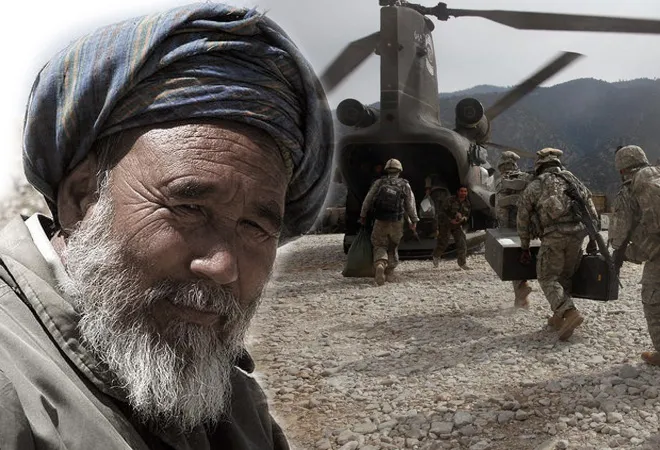-
CENTRES
Progammes & Centres
Location

The loss in Afghanistan can be explained a simple truism, applicable universally, that be it democracy or dictatorship, or something in between, people like to be in charge of their own destiny.Wars are always won or lost in the mind. The Vietnam War, for example, was not lost by the U S Armed Forces in Vietnam, but at home. As the late US Senator John McCain, wrote in the Wall Street Journal “the U.S. never lost a battle against North Vietnam, but it lost the war. Countries, not just their armies, win wars. Giap understood that. We didn’t. Americans tired of the dying and the killing before the Vietnamese did. It’s hard to defend the morality of the strategy. But you can’t deny its success.” There was also that other unalterable reality that Afghanistan was a landlocked country, surrounded by countries, especially those capable of providing access through ports, for the most part antagonistic towards the United States.As a result,over its extended stay in Afghanistan, the United States military was completely dependent on Pakistan for meeting its bulk logistics requirements, forcing it to turn a blind eye towards Pakistan’s deceitful actions of providing unstinted support to the Taliban, in terms of sanctuary, resources and training. However, ironically,from the purely military point of view, the United States is the victim of its own unexpected and unrivalled successes, resulting from the collapse of the Soviet Union. The end of the cold war left it as the only military power of consequence, with relatively weak opponents and a drastically reduced possibility of large scale conventional wars. With strategic imperatives clearly defining the need for ensuring minimal casualties, and a rapid and successful termination of any crisis that impacted US interests or required US intervention, the military looked towards its economic and technological edge to achieve its objectives.
From the purely military point of view, the United States is the victim of its own unexpected and unrivalled successes, resulting from the collapse of the Soviet Union.With the Gulf War of 1991 as the testbed, it embraced,as the cornerstone of what then Secretary of Defense, Donald Rumsfeld, referred to as his “Force Transformation” agenda, arevolution in military affairs (RMA) and network centric warfare (NCW), based on superior information and communication technologies (ICT). This meant dependence on smaller high quality forces supported by precision munitions and a potent and highly effective command, control, communications, computers, intelligence, surveillance, target acquisition and reconnaissance (C4ISTAR) capabilities. The new form of combat involved the ability to move rapidly over great distances and simultaneously engage the enemy in depth and destroy or severely degrade his command and control elements and destroy his war-fighting capabilities, while avoiding collateral damage. The initial phases of the subsequent offensives in Afghanistan and Iraq further validated the doctrine, till its limitations were clearly brought out in the continuing and protracted campaign of attrition that followed. The challenge of asymmetric or irregular warfare accentuated the inadequate availability of “boots on the ground”, lack of social and cultural awareness of the enemy and poor understanding of, and training, in counter-insurgency operations. The fascination of the US military leadership with technology and its version of RMA, along with its utter contempt for capabilities of its potential third world adversaries, led it to ignore the implications of what “Operations Other than War” (OOW) involved. Subsequent events forced the US military to initiate corrective measures which included, unsustainable dependence on Special Operations Forces, and a reorientation in the training syllabi.
The challenge of asymmetric or irregular warfare accentuated the inadequate availability of “boots on the ground”, lack of social and cultural awareness of the enemy and poor understanding of, and training, in counter-insurgency operations.However, all these corrective measures were of little consequence at the time, because any flaw or bias in evolving an appropriate warfighting doctrine impacts performance adversely. Weapons profile, force structures and tactics are closely interlinked and inter-dependent. The visualization of technological advances in itself may not be too difficult, what creates problems is the rapid rate of technological obsolescence and the inevitable time lag that is associated with the R&D and procurement cycle that normally tends to extend over 15-20 years on an average. Finally, as we find ourselves on the cusp of visualising and adopting new military structures and doctrines, the lessons we need to learn from the disasters in Afghanistan and Iraq is not so much about the conduct of military operations there, but more importantly, what kind of a war their military was trained, equipped and organized to fight.
The views expressed above belong to the author(s). ORF research and analyses now available on Telegram! Click here to access our curated content — blogs, longforms and interviews.

Brig. Deepak Sinha (Retd.) was Visiting Fellow at ORF. Brig. Sinha is a second-generation paratrooper. During his service, he held varied command, staff and instructional appointments, ...
Read More +